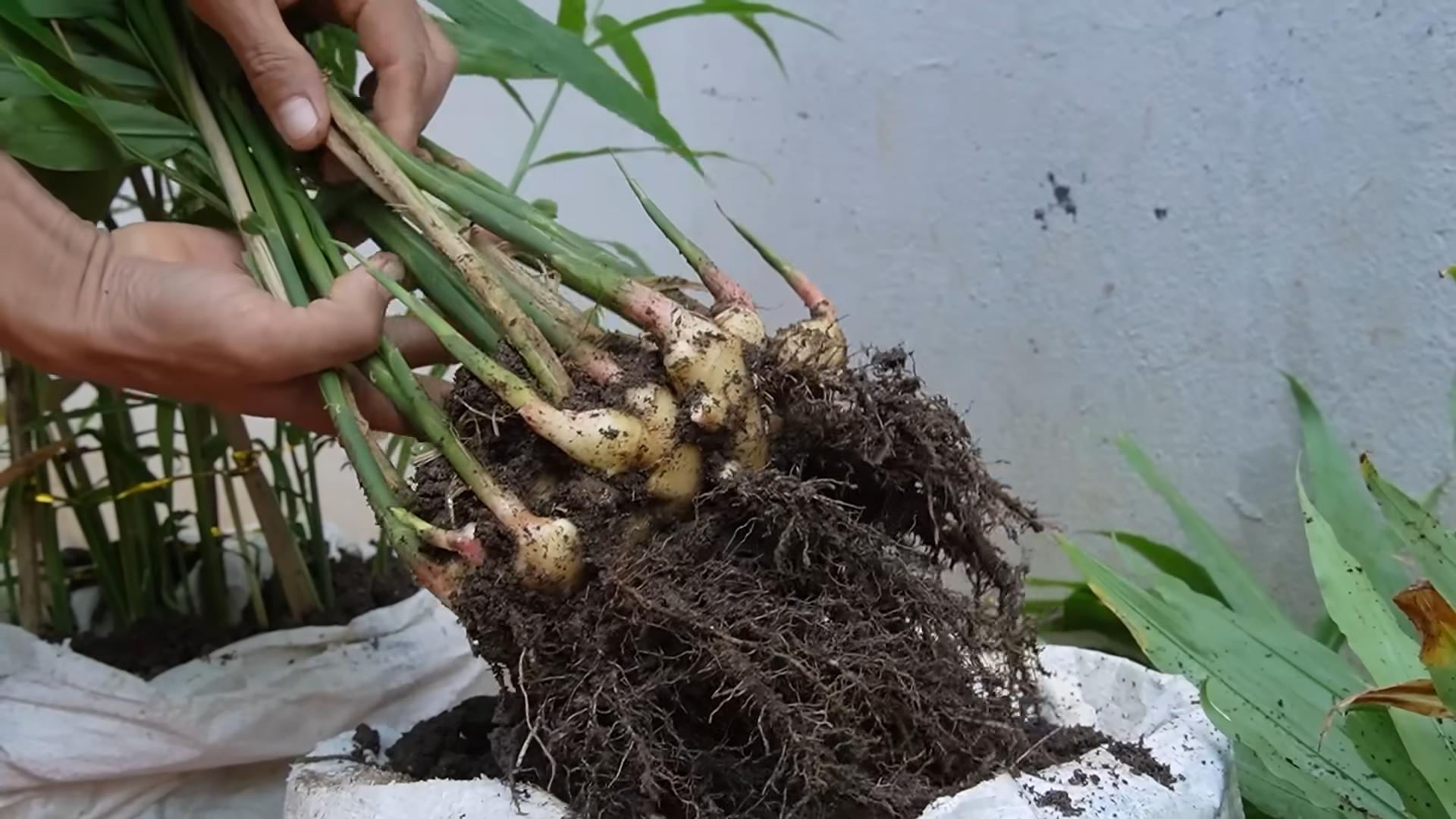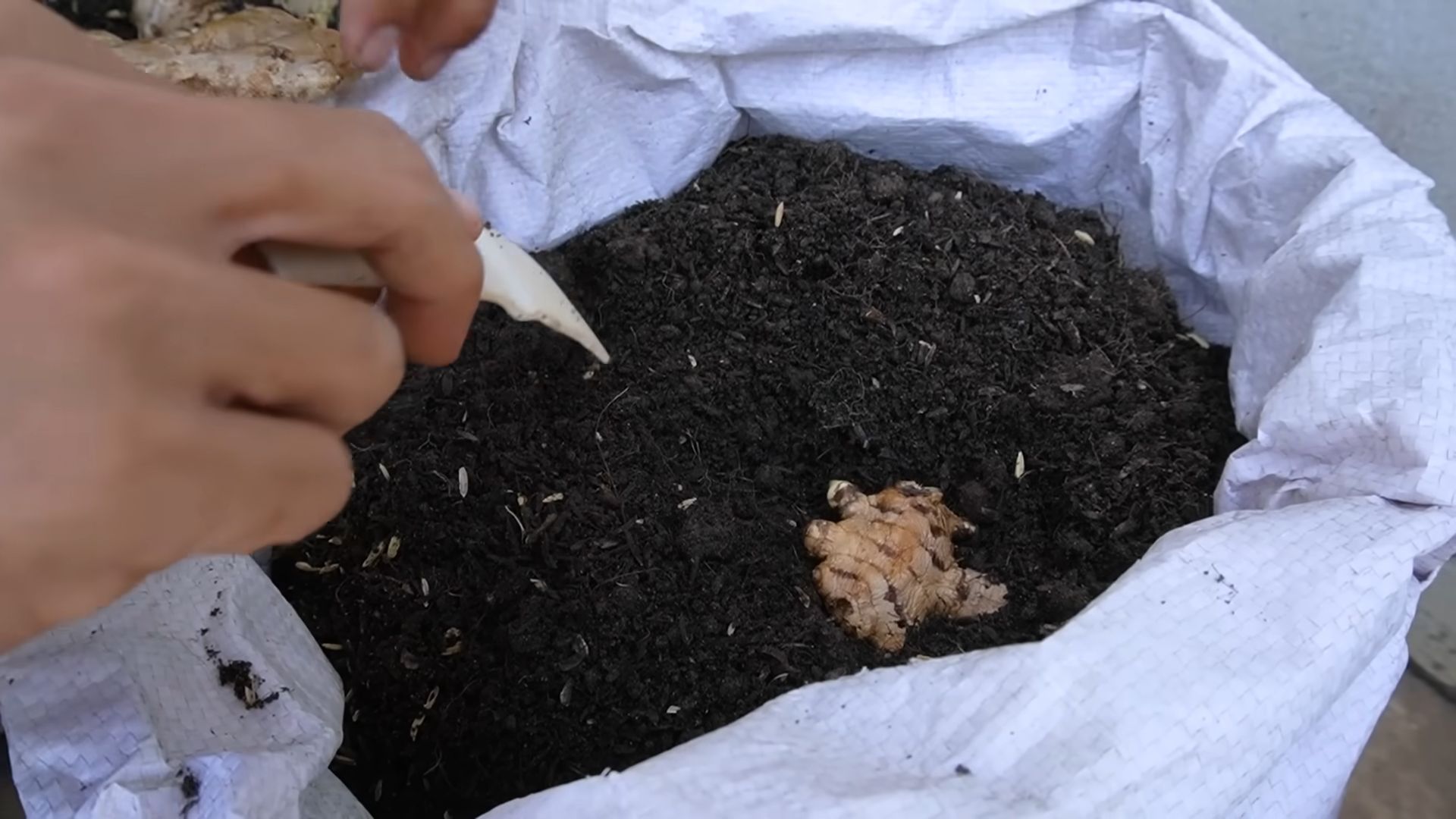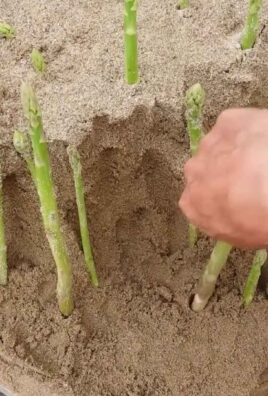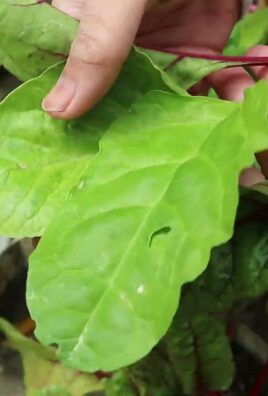Grow Lettuce at Home – imagine stepping outside your back door and snipping fresh, crisp lettuce for your salad, sandwich, or even a healthy smoothie! Forget those limp, pre-packaged greens from the grocery store. I’m going to show you how incredibly easy and rewarding it is to cultivate your own vibrant lettuce patch, right in your own backyard (or even on your balcony!).
Lettuce has a rich history, dating back to ancient Egypt where it was initially cultivated for its seeds and oil. Over time, the leafy greens we know and love were developed, becoming a staple in cuisines worldwide. From the Romans who believed it had medicinal properties to its modern-day presence in countless dishes, lettuce has always held a special place in our diets.
But why should *you* learn to grow lettuce at home? Well, for starters, it’s a fantastic way to save money, reduce your carbon footprint by avoiding those plastic containers, and ensure you’re eating the freshest, most nutritious greens possible. Plus, it’s incredibly satisfying to nurture something from seed to table! In this article, I’ll share my favorite DIY tricks and hacks to help you successfully grow lettuce at home, regardless of your gardening experience or space limitations. Get ready to enjoy a constant supply of delicious, homegrown lettuce – you’ll be amazed at how simple it is!

Grow Your Own Delicious Lettuce: A Beginner’s Guide
Hey there, fellow gardening enthusiasts! Ever dreamt of having fresh, crisp lettuce right at your fingertips? Well, dream no more! Growing your own lettuce is surprisingly easy, even if you don’t have a sprawling garden. I’m going to walk you through everything you need to know to cultivate a thriving lettuce patch, whether you’re working with a small balcony or a backyard plot. Let’s get started!
Choosing Your Lettuce Varieties
First things first, let’s talk lettuce types. There’s a whole world of leafy greens out there, and picking the right varieties for your taste and climate is key. Here are a few popular options:
* Romaine: This is your classic Caesar salad lettuce. It’s sturdy, upright, and has a slightly bitter flavor.
* Butterhead (Boston or Bibb): These are known for their soft, buttery leaves and mild flavor. They’re perfect for delicate salads.
* Loose-leaf: This is the easiest type to grow because you can harvest individual leaves as needed. Popular varieties include Red Sails, Black Seeded Simpson, and Oakleaf.
* Crisphead (Iceberg): This is the most challenging type to grow, as it requires specific temperature conditions. But if you’re up for the challenge, go for it!
Consider your local climate when choosing your varieties. Some lettuce types are more heat-tolerant than others. Loose-leaf varieties are generally the most forgiving.
Getting Started: Planting Your Lettuce
Now, let’s get our hands dirty! You can start lettuce seeds indoors or directly sow them in your garden. I personally prefer starting them indoors for a head start, especially if you live in an area with a short growing season.
Starting Seeds Indoors
1. Gather Your Supplies: You’ll need seed starting trays or small pots, seed starting mix (not regular potting soil!), lettuce seeds, and a spray bottle.
2. Prepare the Seed Starting Mix: Moisten the seed starting mix with water. It should be damp but not soggy.
3. Sow the Seeds: Sprinkle a few seeds into each cell or pot. Cover them lightly with more seed starting mix. Lettuce seeds need light to germinate, so don’t bury them too deep.
4. Water Gently: Use a spray bottle to mist the soil. Avoid overwatering, which can lead to damping off (a fungal disease that kills seedlings).
5. Provide Light: Place the trays or pots under grow lights or in a sunny windowsill. If using a windowsill, rotate them regularly to prevent the seedlings from leaning towards the light.
6. Keep the Soil Moist: Check the soil daily and mist it with water as needed to keep it consistently moist.
7. Thin the Seedlings: Once the seedlings have their first true leaves (the second set of leaves), thin them out, leaving only the strongest seedling in each cell or pot.
Direct Sowing in the Garden
1. Prepare the Soil: Choose a spot in your garden that gets at least 6 hours of sunlight per day. Lettuce prefers well-drained soil that is rich in organic matter. Amend the soil with compost or aged manure before planting.
2. Sow the Seeds: Sow the seeds directly into the soil, spacing them about 1 inch apart. Cover them lightly with soil.
3. Water Gently: Water the soil gently to avoid washing away the seeds.
4. Thin the Seedlings: Once the seedlings emerge, thin them out to the desired spacing, depending on the variety. Romaine and butterhead lettuce need about 8-12 inches of space, while loose-leaf lettuce can be planted closer together.
Transplanting Your Lettuce Seedlings
If you started your lettuce seeds indoors, it’s time to transplant them into your garden!
1. Harden Off the Seedlings: Before transplanting, you need to “harden off” the seedlings. This means gradually exposing them to outdoor conditions over a period of about a week. Start by placing them outside in a sheltered spot for a few hours each day, gradually increasing the amount of time they spend outdoors.
2. Prepare the Planting Area: Choose a spot in your garden that gets at least 6 hours of sunlight per day. Make sure the soil is well-drained and amended with compost or aged manure.
3. Dig Holes: Dig holes that are slightly larger than the root balls of the seedlings.
4. Transplant the Seedlings: Gently remove the seedlings from their trays or pots and place them in the holes. Make sure the top of the root ball is level with the soil surface.
5. Fill in the Holes: Fill in the holes with soil and gently firm the soil around the seedlings.
6. Water Thoroughly: Water the seedlings thoroughly after transplanting.
Caring for Your Lettuce Plants
Now that your lettuce plants are in the ground, it’s time to provide them with the care they need to thrive.
* Watering: Lettuce needs consistent moisture to grow well. Water regularly, especially during hot, dry weather. Aim to keep the soil consistently moist but not soggy.
* Fertilizing: Lettuce is a light feeder, but it will benefit from occasional fertilization. Use a balanced fertilizer or a fertilizer specifically formulated for leafy greens. Follow the instructions on the fertilizer label.
* Weeding: Keep the area around your lettuce plants free of weeds. Weeds compete with lettuce for water and nutrients.
* Pest Control: Lettuce can be susceptible to pests such as aphids, slugs, and snails. Inspect your plants regularly for pests and take action as needed. You can use organic pest control methods such as insecticidal soap or diatomaceous earth.
* Bolting: Bolting is when lettuce plants send up a flower stalk and the leaves become bitter. This usually happens when the weather gets too hot. To prevent bolting, plant lettuce in a shady spot during the summer months and water regularly. You can also choose heat-tolerant varieties.
Harvesting Your Lettuce
The best part of growing your own lettuce is, of course, harvesting it!
* Loose-leaf Lettuce: You can start harvesting loose-leaf lettuce as soon as the leaves are big enough to eat. Simply snip off the outer leaves with scissors, leaving the inner leaves to continue growing.
* Romaine and Butterhead Lettuce: Harvest these types of lettuce when the heads are firm and well-formed. Cut the head off at the base of the plant.
* Crisphead Lettuce: Harvest iceberg lettuce when the heads are firm and dense. Cut the head off at the base of the plant.
Harvest lettuce in the morning, when the leaves are crisp and cool. Store lettuce in the refrigerator in a plastic bag or container. It will keep for several days.
Extending Your Lettuce Season
Want to enjoy fresh lettuce for as long as possible? Here are a few tips for extending your lettuce season:
* Succession Planting: Sow new lettuce seeds every few weeks to ensure a continuous harvest.
* Planting in Containers: Growing lettuce in containers allows you to move the plants to a sheltered location during extreme weather.
* Using Row Covers: Row covers can protect lettuce plants from frost and pests.
* Choosing Heat-Tolerant Varieties: As mentioned earlier, some lettuce varieties are more heat-tolerant than others. Choose these varieties for summer planting.
Troubleshooting Common Lettuce Problems
Even with the best care, you might encounter some problems while growing lettuce. Here are a few common issues and how to address them:
* Damping Off: This fungal disease can kill seedlings. To prevent damping off, use sterile seed starting mix, avoid overwatering, and provide good ventilation.
* Aphids: These tiny insects can suck the sap from lettuce leaves. Control aphids with insecticidal soap or by releasing beneficial insects such as ladybugs.
* Slugs and Snails: These pests can chew holes in lettuce leaves. Control slugs and snails with beer traps, copper tape, or by handpicking them off the plants.
* Bolting: As mentioned earlier, bolting is when lettuce plants send up a flower stalk and the leaves become bitter. Prevent bolting by planting lettuce in a shady spot during the summer months and watering regularly.
Enjoying Your Homegrown Lettuce
Congratulations! You’ve successfully grown your own lettuce. Now it’s time to enjoy the fruits (or rather, leaves) of your labor. Use your fresh lettuce in salads, sandwiches, wraps, or as a garnish. The possibilities are endless!
Growing your own lettuce is a rewarding experience that will provide you with fresh, healthy greens all season long. So get out there and start planting! Happy gardening!

Conclusion
So, there you have it! Growing lettuce at home is not only achievable, but it’s also incredibly rewarding. Forget those limp, pre-packaged greens from the grocery store. Imagine stepping outside your door and harvesting crisp, vibrant lettuce leaves whenever you need them. The difference in taste and texture is truly remarkable, and the satisfaction of knowing you grew it yourself is unparalleled.
This DIY trick, whether you choose the container gardening route, dedicate a small patch in your backyard, or even experiment with hydroponics, offers a sustainable and cost-effective way to enjoy fresh salads and leafy greens year-round. You’re reducing your carbon footprint by eliminating transportation and packaging, and you’re ensuring that your lettuce is free from harmful pesticides and herbicides. Plus, it’s a fantastic way to connect with nature and learn more about the food you eat.
But the benefits don’t stop there. Growing your own lettuce allows for endless customization. Want a spicy kick? Try growing arugula or mustard greens alongside your lettuce. Prefer a milder flavor? Butterhead or romaine lettuce are excellent choices. Experiment with different varieties, soil types, and watering schedules to find what works best for your climate and preferences. You can even succession plant, sowing new seeds every few weeks, to ensure a continuous harvest throughout the growing season.
Consider adding companion plants like marigolds to deter pests or basil to improve the flavor of your lettuce. You can also try growing your lettuce indoors under grow lights during the colder months to extend your harvest. The possibilities are truly endless!
Why is this a must-try? Because it’s fresh, flavorful, sustainable, and fun! It’s a simple way to improve your diet, reduce your environmental impact, and connect with nature.
We strongly encourage you to give this DIY trick a try. Don’t be intimidated if you’re a beginner gardener. Lettuce is relatively easy to grow, and there are plenty of resources available online and at your local garden center to help you along the way. Start small, be patient, and don’t be afraid to experiment.
Once you’ve harvested your first batch of homegrown lettuce, we’d love to hear about your experience! Share your tips, tricks, and photos in the comments below. Let’s create a community of home gardeners who are passionate about growing their own food. Let us know what varieties you tried, what challenges you faced, and what successes you celebrated. Your feedback will help others learn and grow, and it will inspire us to continue sharing helpful gardening tips and tricks. So, grab your seeds, get your hands dirty, and start growing your own delicious lettuce today! You won’t regret it.
Frequently Asked Questions (FAQ)
What is the best time of year to grow lettuce?
Lettuce is a cool-season crop, meaning it thrives in temperatures between 60°F and 70°F (15°C and 21°C). The best time to grow lettuce is in the spring and fall. In warmer climates, you can grow lettuce throughout the winter. Avoid planting lettuce during the hottest months of summer, as it will likely bolt (go to seed) and become bitter. You can extend your growing season by using row covers or planting lettuce in a shaded area.
What kind of soil does lettuce need?
Lettuce prefers well-drained soil that is rich in organic matter. Amend your soil with compost or aged manure before planting to improve its fertility and drainage. A slightly acidic soil pH of 6.0 to 6.8 is ideal for lettuce growth. If your soil is heavy clay, consider growing lettuce in raised beds or containers to improve drainage.
How much sunlight does lettuce need?
Lettuce needs at least six hours of sunlight per day to grow well. However, in warmer climates, it can benefit from some afternoon shade to prevent bolting. If you’re growing lettuce indoors, use grow lights to provide adequate light.
How often should I water lettuce?
Lettuce needs consistent moisture to thrive. Water your lettuce regularly, especially during dry periods. Aim to keep the soil consistently moist but not waterlogged. Water deeply and less frequently, rather than shallowly and more often, to encourage deep root growth. Mulching around your lettuce plants can help retain moisture in the soil.
What are some common pests and diseases that affect lettuce?
Common pests that affect lettuce include aphids, slugs, snails, and cutworms. You can control these pests by handpicking them off the plants, using insecticidal soap, or setting traps. Common diseases that affect lettuce include downy mildew, powdery mildew, and leaf spot. You can prevent these diseases by providing good air circulation, avoiding overhead watering, and using disease-resistant varieties.
How do I harvest lettuce?
You can harvest lettuce leaves as soon as they are large enough to eat. There are two main ways to harvest lettuce: you can harvest the entire head at once, or you can harvest individual leaves as needed. To harvest the entire head, cut it off at the base of the plant. To harvest individual leaves, simply snip them off with scissors or pluck them off by hand. Start with the outer leaves, as these are the oldest and will be the first to become bitter.
How do I prevent lettuce from bolting?
Bolting is when lettuce plants send up a flower stalk and the leaves become bitter. To prevent bolting, plant lettuce in the spring or fall, provide afternoon shade in warmer climates, and water regularly. You can also choose bolt-resistant varieties of lettuce. If your lettuce does start to bolt, you can still harvest the leaves, but they will likely be more bitter.
Can I grow lettuce in containers?
Yes, lettuce grows very well in containers. Choose a container that is at least 6 inches deep and has drainage holes. Use a good-quality potting mix and water regularly. Container-grown lettuce may need to be fertilized more often than lettuce grown in the ground.
What are some good companion plants for lettuce?
Good companion plants for lettuce include carrots, radishes, onions, garlic, and marigolds. Carrots and radishes help to loosen the soil, making it easier for lettuce roots to grow. Onions and garlic deter pests, and marigolds attract beneficial insects.
How do I store harvested lettuce?
To store harvested lettuce, wash it thoroughly and dry it with a salad spinner or paper towels. Store the lettuce in a plastic bag or container in the refrigerator. Lettuce will stay fresh for up to a week if stored properly. You can also wrap the lettuce in a damp paper towel before storing it in a plastic bag to help keep it crisp.




Leave a Comment